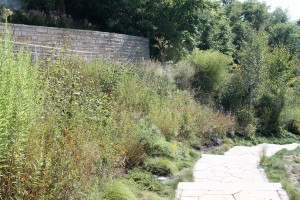Pollinators and Native Plants
October 13th, 2015
Now I know why that kindly older woman asked me after a recent talk whether I thought it was OK if she didn’t rip out the non-native plants in her yard and replace them with natives.
She was asking me for forgiveness for her “sin.”
That became clear as I was researching a Patriot-News/Pennlive.com garden column about new research from England claiming that many non-native plants are useful to pollinators, too, and that our best course is to plant a diverse, continuously blooming mix of all kinds of plants.
That’s what I already thought. But apparently not everyone does.
I’ve noticed a definite increased interest in natives lately. Many gardeners have been telling me they want to add more natives to their landscapes.
But I’m also hearing some people say they don’t want any non-native plants in their yard.
When I ask why, they almost always say they heard that “the pollinators are in trouble” and that the way to save them is to plant native plants.
At first I thought they were exaggerating the message because I’ve heard and read a lot about the benefits of native plants, too, and what I hear is that we should plant more of them, not that non-natives are useless, evil and best eradicated from our landscapes.
As I researched my column, it didn’t take long to find online chats, articles and websites that do, in fact, vilify any plant that wasn’t here when Columbus landed.
I ran into pleas to “GO NATIVE!” (all caps, bold-faced, exclamation point), many pollinator plant lists that include only natives, and even an author who says that “calling non-native plants beneficial to wildlife is ludicrous.”
No wonder people are feeling guilty for wanting to have a peony or a crape myrtle in their yard.
One of the people I interviewed for my column was Dr. Doug Tallamy, the University of Delaware entomology professor who’s author of “Bringing Nature Home,” the de facto manifesto for the native plant/help-the-pollinators movement.
I’ve heard him speak, read his book and chatted with him for about an hour on this whole issue. At no time have I heard him advocate nothing but natives or to call for the eradication of non-natives (except the invasive ones).
His message is actually very common sense.
In a nutshell, he thinks we’ve focused singly on plants as ornaments and ended up with a landscape-plant imbalance that’s typically 80 percent non-native.
With pollinator habitats being destroyed and their food sources being rampantly sprayed as weeds, he says our home gardens are becoming increasingly important refuges.
And he believes we can all be part of the solution by planting more pollinator-useful plants, spraying fewer (or no) pesticides, and replacing our big, ecologically barren lawns with a whole lot more plant diversity.
As a group, he says native plants will do the most good because they have evolved with our native birds, bees, insects and wildlife.
You might be surprised to hear Tallamy say, “I’d use some non-natives, so long as they’re not invasive.”
Dr. Harland Patch, a research entomologist and member of Penn State University’s Center for Pollinator Research, told me the same thing.
Although native plants as a whole deliver the most ecological benefit, many non-natives are beneficial as well.
He suggests a “diversity of mostly native plants along with some well chosen non-natives.”
And Connie Schmotzer, the York County Extension educator who worked on the pollinator trial garden at Penn State’s research farm in Lancaster County, had this to say: “Gardeners should plant a diversity of plants to help pollinators, making sure to have continuous bloom from late March though October. Natives are still the heart of pollinator plants and should make up the majority of species, augmented with non-invasive exotics such as salvias, herbs, vegetables and old-fashioned (heirloom) annuals that haven’t had their nectaries altered to achieve larger, more complex blooms.”
In other words, those messages are pretty much what the somewhat controversial British study concluded.
Actually, if you really want to help pollinators, lean toward more weeds.
If you look at Dr. Tallamy’s research on the most attractive herbaceous plants to moths and butterflies (the caterpillar food that’s a linchpin to ecological health), you’ll find that clover (a native plant) is No. 1 on the list. Dandelion (a non-native) is No. 5; plantain (native) is No. 11; horsenettle (native) is No. 12; knotweed (native) is No. 15; dock (native) is No. 16, and ragweed (native) is No. 18.
Surprisingly, a fair number of veggies and other edibles show up in the top 20, including corn (non-native, No. 2), strawberries (native, No. 6), Brussels sprouts (non-native, No. 9), beans (native, No. 10), lettuce (native, No. 17), and beets (non-native No. 19).
According to Tallamy, it’s the native trees and shrubs that can do the most good in a home landscape, especially oaks, black cherry, willow, birch, poplar, crabapple, blueberry, maple, elm, pine, hickory and hawthorn.
Given the above mix and the prevailing research, it would seem, as Tallamy told me, that all of this is “not as simple as ‘plant natives and save the world.’”
Plant more natives, yes. Do away with all of the non-natives, no.
So if you decide you want to keep your French lilac, you have my permission. And my humble forgiveness.









